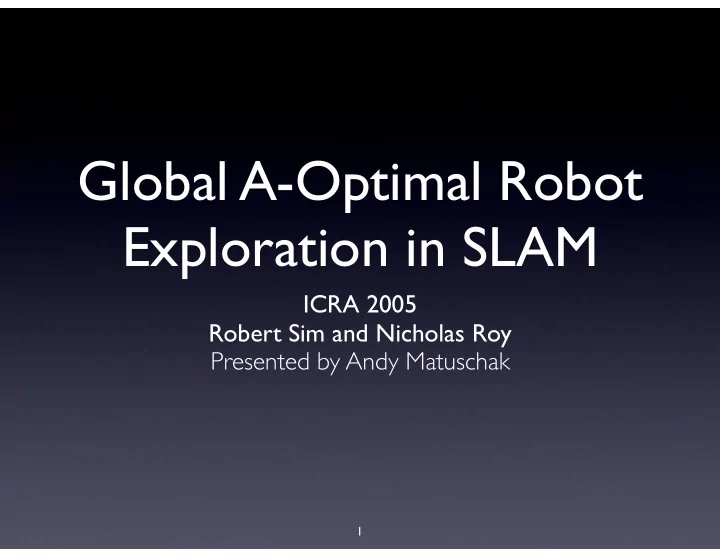

Global A-Optimal Robot Exploration in SLAM ICRA 2005 Robert Sim and Nicholas Roy Presented by Andy Matuschak 1
The Problem 2
The Problem • How do we interpret our sensors’ data? • How can we avoid obstacles and hazards? • What’s the best path to explore the terrain? • What do we do in the event of a Martian attack on our instruments? 3
The Problem • How do we interpret our sensors’ data? • How can we avoid obstacles and hazards? • What’s the best path to explore the terrain? • What do we do in the event of a Martian attack on our instruments? 4
The Problem • How do we interpret our sensors’ data? • How can we avoid obstacles and hazards? • What’s the best path to explore the terrain? • And what does “best” mean? • What do we do in the event of a Martian attack on our instruments? 5
What is “best”? Formulation In general, a state is represented by: Where the features in the environment are at: And the robot’s position is represented by: 6
What is “best”? Formulation The robot takes some action at every step: And takes range and bearing measurements: But the measurements are noisy! We need: 7
What is “best”? Using SLAM • SLAM gives the posterior state distribution • (“ S imultaneous L ocation a nd M apping”) • Assumes noise is Gaussian • Makes increasingly better state estimates • Produces: 8
What is “best”? Entropic Analysis • We need something to minimize! • How much does each move help? • We can try analyzing the system’s entropy. 9
What is “best”? Entropic Analysis • Entropy of a distribution: • Relative entropy after taking some action: • Now, if we have d prior components: • Where and 10
What is “best”? D-Optimal • We want to maximize information gain, • So we want to minimize entropy. • Given , we minimize the covariance determinant. • This is called “d-optimal” minimization. 11
What is “best”? D-Optimal • Determinant is proportional to the volume of a hyperellipsoid where each dimension’s diameter is an eigenvalue of the covariance. • Can send to zero by minimizing one dimension. 12
What is “best”? A-Optimal • Idea: minimize mean error instead of overall variance • Minimize trace instead of determinant: • That’s proportional to the mean for a constant feature count. 13
What is “best”? A-Optimal • The change may seem arbitrary, but: 14
And now, for exploration… 15
Greedy Exploration • At every step, pick the single “best” action. • Fast! • Simple! • Not very effective! 16
Global Exploration • Idea: pick the “best” sequence of actions. • Optimally accurate! • Clearly intractable without manipulation. 17
Pruning the Search • Discretize environment into grid. • Robot can move to 8 connected neighbors. • Find best path which doesn’t cross itself . • Repeat until uncertainty is low enough. 18
Algorithmic Idea • Because paths don’t cross, each point has one best covariance trace. • For each point, we store the best trace and the last point visited in the best path to it. • Only update these if the trace along some other path is lower. • Use a priority queue for the states to speed up convergence. 19
20
21
22
23
24
25
Convergence • No state can be repeated on any trajectory. • Entropy goes down with every measurement, since we prune bad paths. • Therefore, the algorithm converges. 26
Time Analysis • Assume a priority queue with linear search. • For s positions, we have O(s 2 ) updates. • Checking the m- length “parent” list at each step is O(m) . • But the list is bounded by s (no repeats!), so the total running time is O(s 3 ). • This can be much better with faster queues. 27
Performance 28
Performance 29
My Thoughts • Changing the meaning of “best” had huge impact. What other “best”s are good? • How much do we lose by not allowing loops in our paths? • What if making an observation is expensive? 30
Questions? 31
Recommend
More recommend